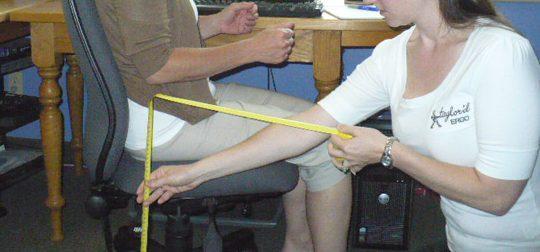We know ours does. How? We follow up. Our ergo assessment process starts AND ends with a comfort survey, which we score. We therefore have quantitative baseline measures of discomfort, by body part, which we can cross-reference to ensure that the changes that we made improved the situation.
There are many comfort surveys available, so go ahead and choose one. We highly recommend using one that includes a score (or creating a scoring system to go with the one you use). Our pre-assessment survey also includes questions about how the employee spends his/her time, what type of vision correction they use, and more. We use it as a way for the employee to prepare for the assessment. A quantitative discomfort survey allows you to:
– focus in on the issues that are of greatest concern to the employee. For example, if the employee has leg pain, the ergonomist may spend more time examining the relationship between the chair and the legs, and less time exploring the fit of the mouse in the hand, or the size of the font on the screen. When we identify postures that are commonly associated with leg pain, we can then look for the driving factors behind them. For example, leg pain could be caused by a seat pan that is too high, which is often, in turn, caused by keyboard that is too high (and not adjustable). “Bad habits” are rarely without a driving factor!
– help the employee’s manager distinguish “nice to do” and “need to do” recommendations. An ergo report might include purchase recommendations for a few items, in addition to a summary of adjustments made, and work practice suggestions for the employee. We will assign a “high” priority to recommendations that are expected to address an injury hazard, and a low priority to optional suggestions that are aimed at improving comfort and productivity.
– prove that you’re making a difference! The post-assessment follow up survey should be compared with the pre-assessment survey. Any outstanding issues should be addressed, and another follow up survey administered. Often, outstanding issues are as simple as a small adjustment to a new chair, or correcting the placement of a new document holder. We rarely need to come on-site again, but it’s important to leave that option open if it’s needed.
How do we know our process works consistently? At Taylor’d Ergo, we have always been very concerned with using a consistent, quantitative approach. All of our ergonomists do assessments the same way. We observe employees at work, looking for work practices and postures that may put them at risk. We measure heights and reaches and compare them with guidelines. We adjust existing equipment, and make cost-effective recommendations to address hazards.
A few years ago, we made a concerted effort to match up a whole bunch of office ergo pre- and post-assessment surveys, and to compare them statistically. We wanted to know if our process was having consistent, positive effects.
We found that:
- In the pre-assessment survey, more than half of all survey respondents reported discomfort in the neck, upper back, lower back, and right wrist.
- Discomfort scores were significantly reduced (p<0.05) for the neck, upper back, lower back, right wrist, as well as both shoulders. Scores were also reduced (although not statistically significantly) almost all other body parts. No scores increased significantly.
We don’t run statistics on survey results all the time, but we do look at every survey that is returned, and we address any outstanding issues with the employee and his/her manager. Shouldn’t you be doing this as well?
Please contact us at info@taylordergo.com if you’d like us to come in to your workplace, and use our proven ergo assessment process to measurably improve employee comfort!


